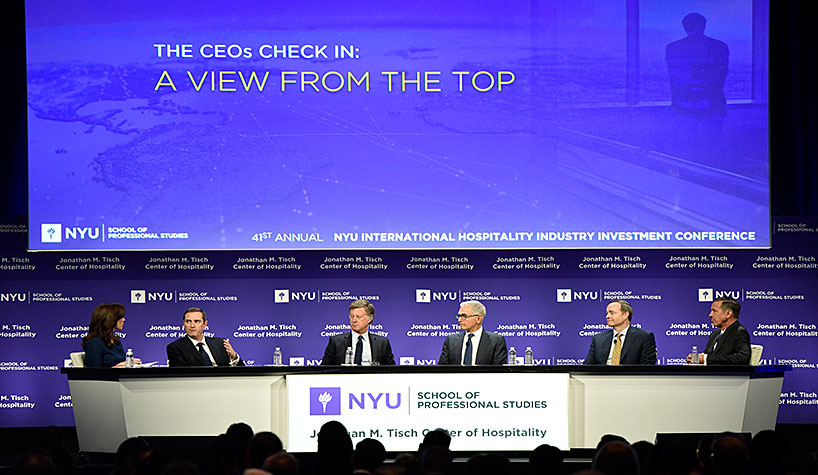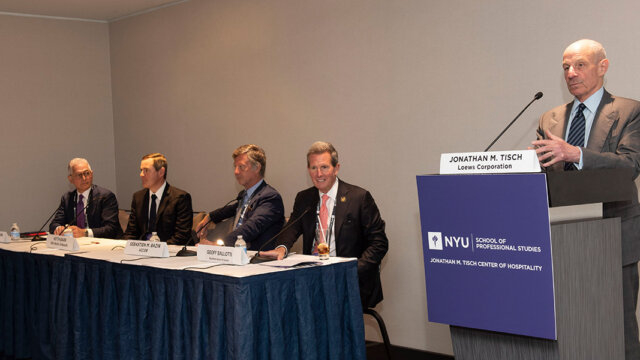NEW YORK—”The CEOs Check In: A View from the Top” session at the annual NYU International Hospitality Industry Investment Conference always provides for a lively discussion, and this year was no exception as among the many topics discussed were brands branching out beyond the traditional hotel model.
The session, moderated by CNBC’s Kelly Evans, included Keith Barr, CEO, InterContinental Hotels Group (IHG); Sébastien M. Bazin, chairman/CEO, Accor; Mark S. Hoplamazian, president/CEO, Hyatt Hotels Corporation; Patrick Pacious, president/CEO, Choice Hotels International; and Arne Sorenson, president/CEO, Marriott International.
Bazin said that his company is embracing co-working in its hotels in Europe. “We have empty square meters of hotel space between 9:30 in the morning and 7 p.m.,” he said. “We are creating a co-working network, where we are indeed taking former office spaces, but we are also adding a 2,000-European hotel network platform, in which through a subscription, you can use the facilities in our hotels between 9 in the morning and 7 at night.”
Using spaces that are underutilized during those hours, while not really adding any additional costs, has its benefits. “It is adding traffic and revenues for the owners,” he said. “It is adding retention stickiness with my corporate clients and it creating is flexible working spaces.”
While IHG is not monetizing the space, for Barr, it is a question of the utilization of public space to benefit the way travelers are working on the road. “We have been redesigning all of the public spaces for our brands,” he said. “We have been taking the traditional lobby design and saying, ‘How can we make it into additional workspace that can be utilized throughout the day? How can you activate it and create areas for people to work and engage socially.’”
He said the company started rolling that redesign out in Europe two years ago, with 80% of its portfolio done already. “Revenue is significantly up. We have seen higher footfall traffic,” he said.
People are using space differently according to Barr. “We need to change the way we build hotels to reflect how people are working,” he said.
Given Marriott’s recent launch of Homes and Villas, its own home-sharing platform, the panelists also discussed the often-controversial area of hospitality. “We thought, ‘Let’s get into it in the space where we are going to comply with the law,’” said Sorenson. “We believe the playing field has to be level between hotels and home-sharing. Second, let’s put units where the brand can stand behind it. That means housekeeping services, design services and standby services if something goes wrong.”
While the listings on Marriott’s platform are also listed on other home-sharing sites, Sorenson said that they drove more volume to the listings than Booking.com because of the Marriott loyalty program.
Pacious said that Choice has offered its own home-sharing platform for three years, with 30,000 listings, and similar to Marriott, all of them are placed by professionally managed operations.
He thinks this part of the business can be quite sizable. “A lot of this is the power of your global program… It has allowed us to [offer guests] more for their points that they can’t get in the Choice Hotels system,” he said.
Hoplamazian thinks the control provided by these new platforms is what will make them successful and that the undifferentiated sharing marketplace is a business model that is not durable. “I think, a year or two from now, we are not going to be talking about Airbnb as a lodging hospitality company; we are going to be talking about them as a distribution business,” he said. “That is really where it is headed… 100% of their actions have been leading toward a distribution platform. There is a reason for that. If the whole business was vibrant and there was durable growth and it was a good model and it wasn’t otherwise running into more supply constraints with respect to regulatory environments in respect to many markets around the world, you wouldn’t see that in the dividend, but they are. I guess that they get an A for agility, but I don’t think that that core model is actually going to work long term.”


